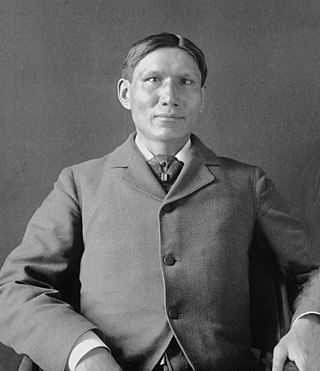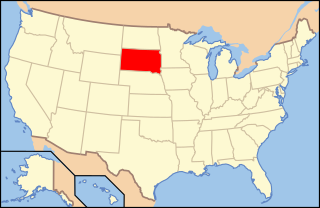Related Research Articles
Page most commonly refers to:

South Dakota is a landlocked state in the North Central region of the United States. It is also part of the Great Plains. South Dakota is named after the Dakota Sioux tribe,which comprises a large portion of the population —with nine reservations currently in the state —and has historically dominated the territory. South Dakota is the 17th-largest by area,but the fifth-least populous,and the fifth-least densely populated of the 50 United States. Pierre is the state capital,and Sioux Falls,with a population of about 213,900,is South Dakota's most populous city. The state is bisected by the Missouri River,dividing South Dakota into two geographically and socially distinct halves,known to residents as "East River" and "West River". South Dakota is bordered by North Dakota to the north,Minnesota to the east,Iowa to the southeast,Nebraska to the south,Wyoming to the west,and Montana to the northwest.
These are tables of congressional delegations from South Dakota to the United States Senate and United States House of Representatives.

The Dakota,Minnesota and Eastern Railroad is a wholly owned U.S. subsidiary of the Canadian Pacific Kansas City. Before its purchase,it was the largest Class II railroad in the United States,operating across South Dakota and southern Minnesota in the Northern Plains of the United States. Portions of the railroad also extended into Wyoming,Nebraska,Iowa,and Illinois. It interchanged with all seven U.S. Class I railroads.

The Red River Valley and Western Railroad is a regional railroad operating in the US states of North Dakota and Minnesota. It began operations in 1987 in an era of railroad restructuring.

Hannah Dakota Fanning is an American actress. She rose to prominence as a child actress at the age of seven for playing the daughter of an intellectually challenged man in the drama film I Am Sam (2001),for which she received a Screen Actors Guild Award nomination,making her the youngest nominee in SAG history. Fanning had further roles as a child actress in Taken (2002),Uptown Girls (2003),The Cat in the Hat (2003),Man on Fire (2004),War of the Worlds (2005),Charlotte's Web (2006),The Secret Life of Bees (2008) and the lead voice role in Coraline (2009).

South Dakota Amendment C of 2006 is an amendment to the South Dakota Constitution to make it unconstitutional for the state to recognize or perform same-sex marriages,or to recognize civil unions,domestic partnerships,or other quasi-marital relationships regardless of gender. The referendum was approved on 7 November 2006 by 52% of the state's voters.

The Dakota are a Native American tribe and First Nations band government in North America. They compose two of the three main subcultures of the Sioux people,and are typically divided into the Eastern Dakota and the Western Dakota.

The structure of the government of South Dakota is based on that of the federal government,with three branches of government:executive,legislative,and judicial. The structure of the state government is laid out in the Constitution of South Dakota,the highest law in the state. The constitution may be amended either by a majority vote of both houses of the legislature,or by voter initiative.

The 1932 United States Senate election in South Dakota took place on November 8,1932. Incumbent Republican Senator Peter Norbeck ran for re-election to a third term. After easily turning back a challenge from former State Senator Harry F. Brownell in the Republican primary,Norbeck faced attorney Ulysses Simpson Grant Cherry,the Democratic nominee,in the general election. Owing in part to Franklin D. Roosevelt's landslide victory in South Dakota,the race was much closer than it was in 1926,but Norbeck still defeated Cherry by a decisive margin to win his third,and final,term. Norbeck died in office on December 20,1936,triggering a special election in 1938.
The 2005 NCAA Division I baseball season play of college baseball in the United States,organized by the National Collegiate Athletic Association (NCAA) at the Division I level,began on January 21,2005. The season progressed through the regular season,many conference tournaments and championship series,and concluded with the 2005 NCAA Division I baseball tournament and 2005 College World Series. The College World Series,which consisted of the eight remaining teams in the NCAA tournament,was held in its annual location of Omaha,Nebraska,at Rosenblatt Stadium. It concluded on June 26,2005,with the final game of the best of three championship series. Texas defeated Florida two games to none to claim its sixth championship.

Paleontology in South Dakota refers to paleontological research occurring within or conducted by people from the U.S. state of South Dakota. South Dakota is an excellent source of fossils as finds have been widespread throughout the state. During the early Paleozoic era South Dakota was submerged by a shallow sea that would come to be home to creatures like brachiopods,cephalopods,corals,and ostracoderms. Local sea levels rose and fall during the Carboniferous and the sea left completely during the Permian. During the Triassic,the state became a coastal plain,but by the Jurassic it was under a sea where ammonites lived. Cretaceous South Dakota was also covered by a sea that was home to mosasaurs. The sea remained in place after the start of the Cenozoic before giving way to a terrestrial mammal fauna including the camel Poebrotherium,three-toed horses,rhinoceroses,saber-toothed cat,and titanotheres. During the Ice Age glaciers entered the state,which was home to mammoths and mastodons. Local Native Americans interpreted fossils as the remains of the water monster Unktehi and used bits of Baculites shells in magic rituals to summon buffalo herds. Local fossils came to the attention of formally trained scientists with the Lewis and Clark Expedition. The Cretaceous horned dinosaur Triceratops horridus is the South Dakota state fossil.

The 1920 United States Senate election in South Dakota took place on November 2,1920. Incumbent Democratic Senator Edwin S. Johnson declined to seek re-election to a second term. In the Democratic primary,attorney Ulysses Simpson Grant Cherry defeated former State Senator Louis Napoleon Crill and former U.S. Marshal Tom Taubman,while in the Republican primary,Governor Peter Norbeck defeated former State Supreme Court Justice Dick Haney. In the general election,Cherry and Norbeck faced a litany of independent candidates,including Nonpartisan League candidate Tom Ayres. Benefiting from the split in left-wing candidates,Norbeck won by a wide margin,with Ayres narrowly beating out Cherry for second place.

The 1914 United States Senate election in South Dakota took place on November 3,1914. Incumbent Senator Coe I. Crawford,a Republican,sought re-election in his first popular election. He was defeated in the Republican primary by Congressman Charles H. Burke,the House Minority Whip. In the general election,he was narrowly defeated by Edwin S. Johnson,the 1912 Democratic nominee for Governor,who won a narrow plurality. Edwin Stockton Johnson became the first Democrat ever to have been elected to the United States Senate from South Dakota and the first non-Republican to have been elected to the United States Senate from South Dakota since James Henderson Kyle in 1897.

The 1918 United States Senate election in South Dakota took place on November 5,1918. Incumbent Republican Senator Thomas Sterling sought re-election in his first popular election. He defeated former Governor Frank M. Byrne in the Republican primary and then faced former State Representative Orville Rinehart,the 1916 Democratic nominee for Governor,in the general election. Sterling defeated Rinehart,along with independent candidate W. T. Rafferty,by a wide margin to win re-election.

The 1908 South Dakota gubernatorial election was held on November 3,1908. Incumbent Republican Governor Coe I. Crawford opted to run for the U.S. Senate rather than run for re-election. State Senator Robert S. Vessey narrowly won the Republican primary over former State Representative John L. Browne and advanced to the general election,where he faced the Democratic nominee,former Governor Andrew E. Lee. Though Vessey's performance was significantly reduced from Crawford's performance in 1906,he still defeated Lee by a wide margin.

The 1934 South Dakota gubernatorial election was held on November 6,1934. Incumbent Democratic Governor Tom Berry ran for re-election to a second term. After defeating an intra-party challenge from Lieutenant Governor Hans Ustrud,Berry faced magazine publisher William C. Allen,who won a crowded Republican primary with a large plurality. Aided by the national environment favoring Democrats,Berry won re-election in a landslide.

The 1938 South Dakota gubernatorial election was held on November 8,1938. Incumbent Republican Governor Leslie Jensen declined to seek re-election and instead unsuccessfully ran for the U.S. Senate. Harlan J. Bushfield,the former chairman of the South Dakota Republican Party,won the Republican primary to succeed Jensen. In the general election,he faced Democratic nominee Oscar Fosheim,a state representative from Miner County,in the general election. Bushfield defeated Fosheim by a relatively close margin,winning his first term as governor.